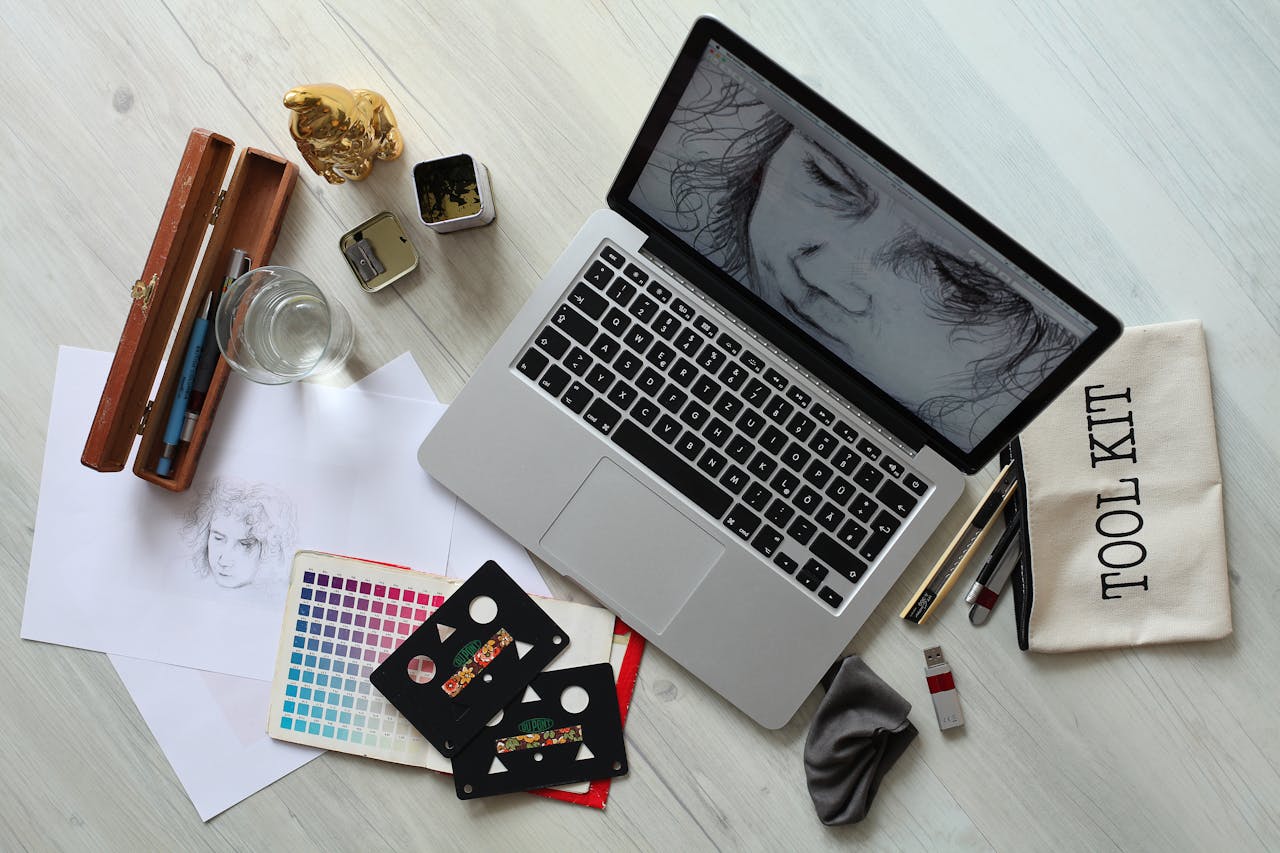So, what’s the deal with graphic designing?
Scope of graphic designing: Okay, picture this. We’re sitting at a cozy little café, sipping something overpriced, and I ask, “Hey, have you ever thought about how literally everything you see online or in stores has some designer’s fingerprint on it?” Graphic design isn’t just about making things look cool (though that’s part of it). It’s how companies, influencers, brands—heck, even your favorite coffee shop—communicate with people visually.
Think of it like this: graphic design is the visual version of a first impression. And in today’s world, that first impression can make or break your business. One bad logo or clunky website, and people bounce. But get the vibe right? You’ve got their attention. That’s the power of graphic design.

Why should I care, though?
You’re probably thinking, “Cool, but why should I care?” Fair question. Here’s the real talk, especially if you’re Gen Z:
-
Student loans are a beast: Side hustles matter. If you’re even a little creative, you can start designing and make decent money on the side—or turn it full-time.
-
Dreams of travel or buying your first car/home? You’re not alone. Graphic design is a solid remote-friendly career. Freelancing or remote jobs can literally fund your goals.
-
Job competition is wild out there: Everyone’s got a degree now. But can everyone design? Nope. If you’ve got the skills, that sets you apart.
Design gives you options. You can freelance, work with agencies, build your own brand, or even launch a startup. It’s flexible, creative, and pretty future-proof if you play your cards right.
What’s the scope, especially here in Pakistan?
Graphic design is booming. And no, that’s not just some motivational fluff—it’s real. Businesses are finally realizing they need solid branding, good UI, clean visuals for social media, and packaging that actually makes people stop scrolling. That’s where designers step in.
Here’s where graphic designers are getting hired:
-
Marketing and ad agencies
-
Tech startups and software houses
-
E-commerce brands
-
Educational platforms
-
YouTubers, influencers, and podcasters
-
NGOs, events, and publications
Even small businesses are looking for someone who can handle their online presence—logos, posters, social media posts, the whole deal.
And then there’s freelancing. A lot of designers in Pakistan are working with international clients. Some start small, but once they build a good portfolio, they can charge in dollars. You do the math.
How much money are we talking?
Let’s break it down. If you’re just starting out, fresh out of school or learning on your own, you might start somewhere around 30 to 50k PKR a month. It’s not life-changing, but it’s a solid beginning.
But with experience and the right skills? You can easily hit six figures. Designers who specialize in high-demand niches like UI/UX or motion graphics are often earning even more, especially if they’re working with foreign clients.
And freelancing? Some people are pulling in $800 to $1,500 a month just by working online, without even leaving their bedrooms. No fancy degree. Just skills, hustle, and a good portfolio.
What areas should you specialize in?
Graphic design isn’t just “make a logo and go.” It’s a big, beautiful world of specialties. If you want to grow and stand out, consider diving into one of these:
-
UI/UX Design – Apps and websites that are easy to use and look good doing it.
-
Motion Graphics – Short animations, reels, ads, explainer videos.
-
Branding & Identity – Logos, colors, fonts, tone—basically building the personality of a brand.
-
Packaging Design – The stuff that makes products pop on shelves (or screens).
-
Social Media Content Design – Instagram posts, YouTube thumbnails, digital flyers.
-
Infographics & Data Visualization – Making complex stuff easy to understand.
Each of these areas is growing, especially the digital-heavy ones. Print design still exists, but digital is where most of the demand (and money) is headed.
What about AI and templates? Is design dying?
Honestly? No, it’s not. But the game is changing.
Yes, there are tools like Canva, and yes, AI can generate designs. But here’s the truth: those tools are great for basic stuff. You can make a birthday invitation or a poster in five minutes. But when it comes to branding, storytelling, or solving a client’s actual business problem, a template won’t cut it.
Businesses want strategy, creativity, and originality. They want designs that speak directly to their target audience. That’s where you come in.
If you just rely on templates or basic skills, yeah—you’ll get left behind. But if you learn how to think like a designer, build brands, and understand users, you’re not just surviving—you’re thriving.

What skills do you actually need?
Alright, let’s keep it real. To get started (and succeed), here’s what you need under your belt:
Tools:
-
Adobe Photoshop
-
Illustrator
-
InDesign
-
Figma
-
After Effects (for motion work)
Creative skills:
-
Color theory
-
Typography
-
Composition
-
Visual hierarchy
-
Concept development
Soft skills:
-
Communication (yes, you have to talk to clients)
-
Time management
-
Feedback handling (some clients will test your patience)
-
Problem-solving
And here’s a pro tip: don’t just learn the tools. Anyone can press buttons. The real magic is knowing why you’re designing something a certain way. What’s the message? Who’s the audience? What’s the goal?
Also Read: Unlock the Full Potential of Canva Pro Today
Career paths—what does the future look like?
If you’re just starting out, you’ll probably begin as a junior designer. You’ll do basic stuff, learn the ropes, get a feel for working with clients or a team.
From there, you can move up:
-
Mid-level Designer
-
Senior Designer
-
Art Director
-
Creative Director
Or you can go solo. Start your own studio. Launch a digital product. Build your own brand. Tons of designers end up doing their own thing after gaining some experience.
Let’s get honest for a sec—what are the challenges?
No sugarcoating here. This field is fun, but it’s not always easy.
-
The market is competitive. Especially the entry-level scene. You’ve got to find your unique edge.
-
Burnout is real. Creative work can be mentally exhausting, especially with tight deadlines and picky clients.
-
Payments can be slow. Especially with freelance clients who vanish after the first draft.
-
It takes time to build a good portfolio and reputation. Don’t expect overnight success.
But hey, every job has challenges. The key is knowing what you’re walking into—and playing the long game.
So… is it worth it?
If you’re creative, love solving visual problems, and enjoy seeing your work come to life—absolutely, yes.
Graphic design gives you freedom. It gives you options. You can work with local brands or international clients. You can build websites, apps, packaging, content—stuff that people actually interact with every day.
It’s not just a job. It’s a skill you can carry with you anywhere. And in a world that’s only getting more digital, that’s a powerful thing to have in your back pocket.
Final thoughts—here’s what your friend wants you to know
Graphic design isn’t going anywhere. It’s evolving, sure. But the need for visual thinkers, storytellers, and creative problem-solvers? That’s not changing.
So if you’ve got that itch to create—and you’re willing to learn, adapt, and keep getting better—this path has a lot to offer. And who knows? A couple years from now, we might be sitting down again, and you’ll be the one telling me about your design studio, your freelance clients, or that dream project you just wrapped up.
Seriously, if this is something you love doing, don’t sleep on it. Learn the craft. Build your skills. And get started—because this digital world isn’t going to design itself.
FAQs
What is the scope of graphic design?
Graphic design has a wide and growing scope, especially in today’s digital-first world. From branding and social media to web design, packaging, and even mobile app interfaces, nearly every industry needs some form of visual communication. It’s not just about making things look good—it’s about helping businesses tell their story, attract customers, and stand out in crowded markets. With the rise of online content, e-commerce, and digital marketing, graphic designers are more relevant than ever.
Also Read: The Real Deal on SEO in Pakistan: What Actually Works in 2025
Is graphic designing a good career?
Yes, graphic design can absolutely be a good career—especially if you’re creative, enjoy solving problems visually, and are open to learning new tools and trends. It offers flexibility, whether you want to work in a company, at an agency, or freelance on your own terms. While it can be competitive, designers who stay sharp, build a strong portfolio, and specialize in high-demand areas (like UI/UX or motion design) often find plenty of opportunities and decent pay.
What is the scope of BS graphic design in Pakistan?
A BS in Graphic Design in Pakistan opens doors in various sectors such as advertising, media, education, tech, and design studios. Graduates can find work as graphic designers, brand identity specialists, UI/UX designers, visual content creators, or even start their own freelance business. While the local market can be tough for beginners, those who stay consistent and build a strong skill set often end up working for international clients or digital agencies with competitive pay.
Is graphic design in demand in Pakistan?
Yes, graphic design is in demand in Pakistan, especially as businesses move online and digital marketing continues to grow. Startups, e-commerce platforms, influencers, and even small local businesses are constantly looking for people to design logos, social media content, websites, and ads. Additionally, tech companies and software houses often need UI/UX designers, which is a fast-growing branch of graphic design in the country.
Is graphic design high paying?
It can be, but it depends on your experience, specialization, and how you market yourself. Beginners might start with modest salaries, but experienced designers, especially those skilled in UI/UX, motion graphics, or branding, can earn well. Freelancers working with international clients often make significantly more, thanks to dollar-based projects. So while it may not be “high paying” at first, it has strong potential with the right skills and strategy.
Does graphic design have a future?
Definitely. Graphic design isn’t going anywhere. While tools like AI and templates are changing how some things are done, they’re not replacing creativity, strategy, and visual storytelling. Designers who adapt, specialize, and keep learning will always have a place in industries that need human creativity—especially in branding, UX design, and digital media. The future may look different, but the demand for smart, creative visual thinkers is here to stay.




